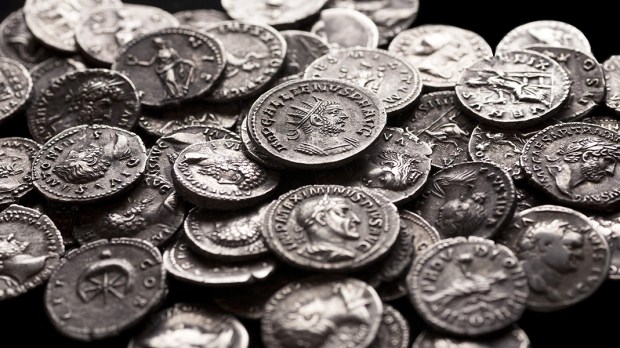Jesus sat down opposite the treasury
and observed how the crowd put money into the treasury.
Many rich people put in large sums.
A poor widow also came and put in two small coins worth a few cents.
Calling his disciples to himself, he said to them,
“Amen, I say to you, this poor widow put in more
than all the other contributors to the treasury.
For they have all contributed from their surplus wealth,
but she, from her poverty, has contributed all she had,
her whole livelihood.” – Mark 12:41-44
Mark’s Gospel tells us the widow’s two coins were worth “a few cents.” If we stop there, we see that she has given much, as Jesus points out, from her meager means. It is remarkable to meditate upon the fact that God sees differently than we do. That far from praising the rich who put in large sums, Jesus draws our attention to the gift of the widow.
What does the widow’s gift mean? Certainly her gift was worthy because it was sacrificial. She would have felt the gift more, giving more from a limited income than even large sums given by a rich man. But ultimately what is measured is the woman’s love. St. Leo the Great reminds us,
On the scales of divine justice the quantity of gifts is not weighed, but the weight of hearts. The widow deposited in the Temple treasury two small coins and by doing so surpassed the gifts of all the rich. No gesture of goodness is meaningless before God, no mercy is left barren. (Sermo de jejunio dec. mens., 90, 3).
But we might find greater symbolism still in the widow’s two coins.
1. Love of God, love of neighbor
We might call to mind Jesus’ reply when a scribe asks him which is the greatest commandment. This instance occurs just a few lines before the recounting of the widow’s mite, in the same chapter in Mark’s Gospel. The Lord says, “You shall love the Lord your God with all your heart, with all your soul, with all your mind, and with all your strength.’ The second is this: ‘You shall love your neighbor as yourself.’ There is no other commandment greater than these” (Mark 12:30-13).
We might think of the two coins as symbolizing this. The widow, generous out of love for God, gives to the Temple. Today many gifts to the Church sustain worship (love of God) and are also used in service to the poor (love of neighbor).
2. The New Testament and Old Testament
We might also see in the two coins the two components of the Christian Bible. The Old Testament, Jesus assures us, is not cast off, but rather fulfilled in him. Jesus teaches, “Do not think that I have come to abolish the law or the prophets. I have come not to abolish but to fulfill” (Matt 5:17). He is the completion of God’s ancient promises made to Israel.
Christ, however, is also a new lawgiver. As the Son of God, he gives us a taste of heaven not known until him. He reveals new truths, pulling back the veil further into the mystery of God. Christ is, as Hebrews says, our great High Priest, who enters “heaven itself, that he might now appear before God on our behalf” (Heb 9:24).
3. The 10 Commandments and the Beatitudes
In a similar vein, Christians are not dispensed from the Ten Commandments. This sanctifying way of life, first given to Israel through Moses, is still followed by Christians. We do not murder. We do not steal. We honor God and our parents.
But Christ also gives a richer way of life. He assures us that the humility of the widow, elaborated by the Beatitudes is the way of holiness. Again, God does not see as we see. The way of life of Christ, the way of holiness he proposes in the Sermon on the Mount, is a way of littleness, a way of love. The ways of heaven are not the ways of the world.
4. Faith and Charity
Pope Benedict teaches, “God always asks for our free adherence to faith, that it is expressed in love for him and for our neighbour. No one is so poor that he cannot give something.” It is not enough to merely know God, God must be loved!
There’s a Thomistic axiom that asserts: a thing cannot be loved unless it is first known. That is, in order to truly love something, it must be know. A Christian will probably agree, dismissing with ease, the old myth of “love at first sight.” To know something or someone allows the lover to give him or herself fully.
This doesn’t mean we have to know God exhaustively. In fact, that’s impossible because we are finite and God is infinite. But it does mean that in order to love God well, we have to known some true things about Him.
5. Faith and Reason
John Paul II teaches, “Faith and reason are like two wings on which the human spirit rises to the contemplation of truth; and God has placed in the human heart a desire to know the truth—in a word, to know himself—so that, by knowing and loving God, men and women may also come to the fullness of truth about themselves.” The human intellect, with horizons augmented by Divine Revelation, can probe the deepest questions of life: Who am I? What was I made for?
The Church considers human reason, especially as exercised in philosophy (love of wisdom!), an indispensable means for coming to understand the faith and for the work of evangelization. But reason alone is not sufficient. Only faith, the grace of inspired knowing of God, allows the believer to drink deeply of the draught of God’s own inner life.



